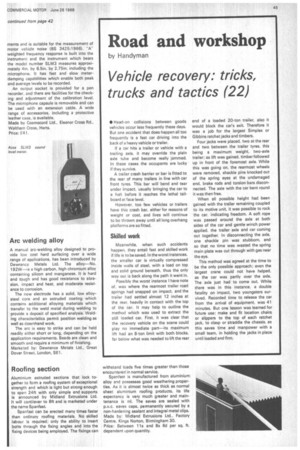Road and workshop
Page 47

If you've noticed an error in this article please click here to report it so we can fix it.
by Handyman
Vehicle recovery: tricks, trucks and tactics (22)
• Head-on collisions between goods vehicles occur less frequently these days. But one accident that does happen all too frequently is a fast car driving into the back of a heavy vehicle or trailer.
If a car hits a trailer or vehicle with a trailing axle, it may override the plain axle tube and become really jammed. In these cases the occupants are lucky if they survive.
A trailer crash barrier or bar is fitted to the rear of many trailers in line with car front tyres. This bar will bend and tear under impact, usually bringing the car to a halt before it reaches the lethal tailboard at face level.
However, too few vehicles or trailers have this crash bar, either for reasons of weight or cost, and lives will continue to be thrown away until all long overhang platforms are so fitted.
Skilled wort
Meanwhile, when such accidents happen, they entail fast and skilled work if life is to be saved. In the worst instances, the smaller car is virtually compressed inside walls of steel, with a load on top and solid ground beneath, thus the only way out is back along the path it went in.
Possibly the worst instance I have note of, was where the rearmost trailer road springs had snapped on impact, and the trailer had settled almost 12 inches at the rear, heavily in contact with the top of the car. It may help to outline the method which was used to extract the still loaded car. First, it was clear that the recovery vehicle on the scene could play no immediate part—its maximum lift had an 8-ton limit with both blocks, far below what was needed to lift the rear end of a loaded 20-ton trailer, also it would block the car's exit. Therefore it was a job for the largest Simplex Or Gibbins ratchet jacks and timbers.
Four jacks were placed, two at the rear and two between the trailer tyres, this being a maximum weight, two-axle trailer; as lift was gained, timberfollowed up in front of the foremost axle. While this was going on, the rearmost wheels were removed, shackle pins knocked out of the spring eyes at the undamaged end, brake rods and torsion bars disconnected. The axle with the car bent round it was then free.
When all possible height had been gained with the trailer remaining coupled to its motive unit, it was possible to rock the car, indicating freedom. A soft rope was passed around the axle at both sides of the car and gentle winch power applied, the trailer axle and car coming out together. In disconnecting the axle, one shackle pin was stubborn, and so that no time was wasted the spring main plate was cut through with gas near the eye.
This method was agreed at the time to be the only possible approach: even the largest crane could not have helped, as the car was partly over the axle. The axle just had to come out. While there was in this instance, a double fatality on impact, two youngsters survived. Recorded time to release the car from the arrival of equipment, was 41 minutes, But one lesson was learned for future use: make and fit location chairs or slippers to the top of each ratchet jack, to clasp or straddle the chassis, as this saves time and manpower with a small team, in holding the jacks in place until loaded and firm.
























































































































